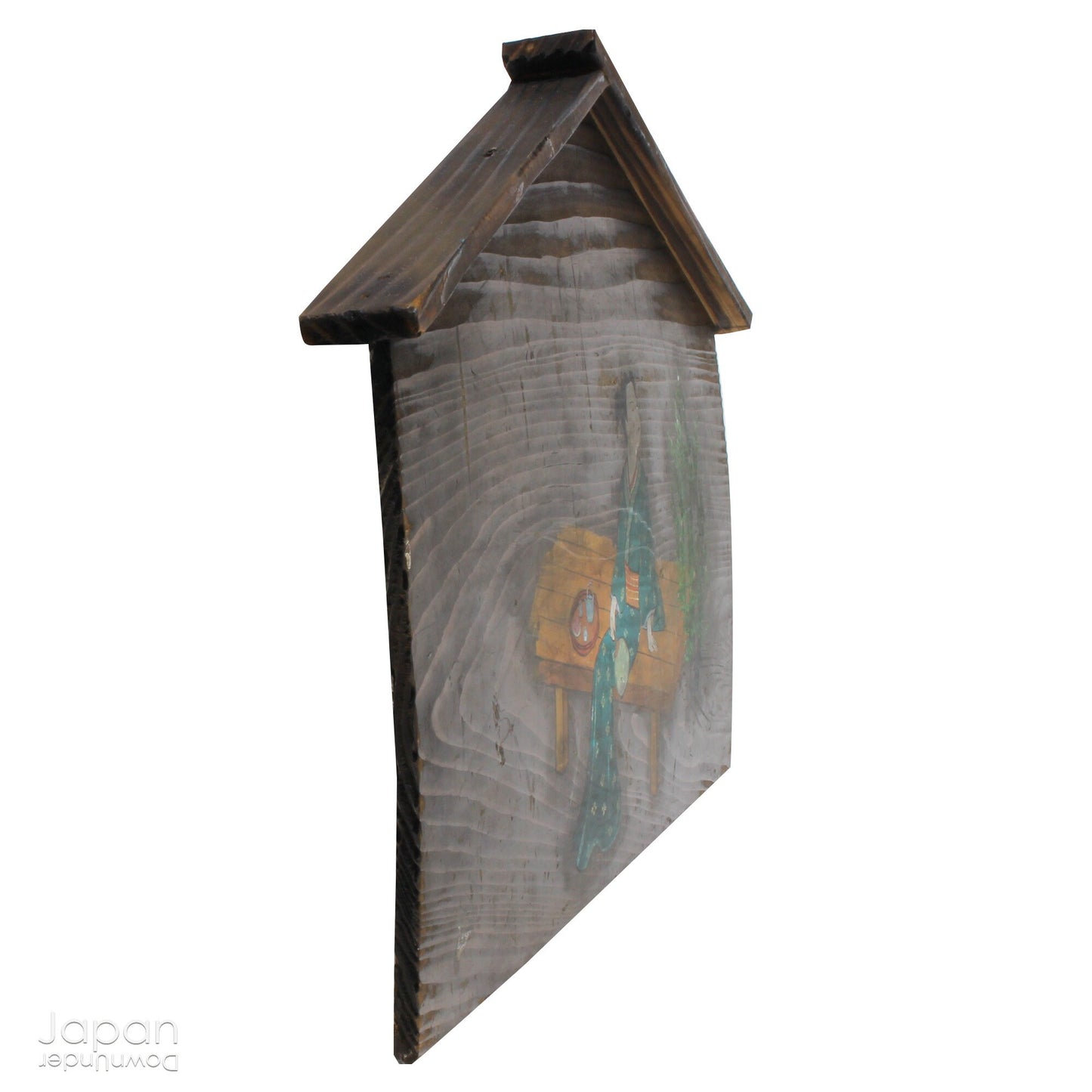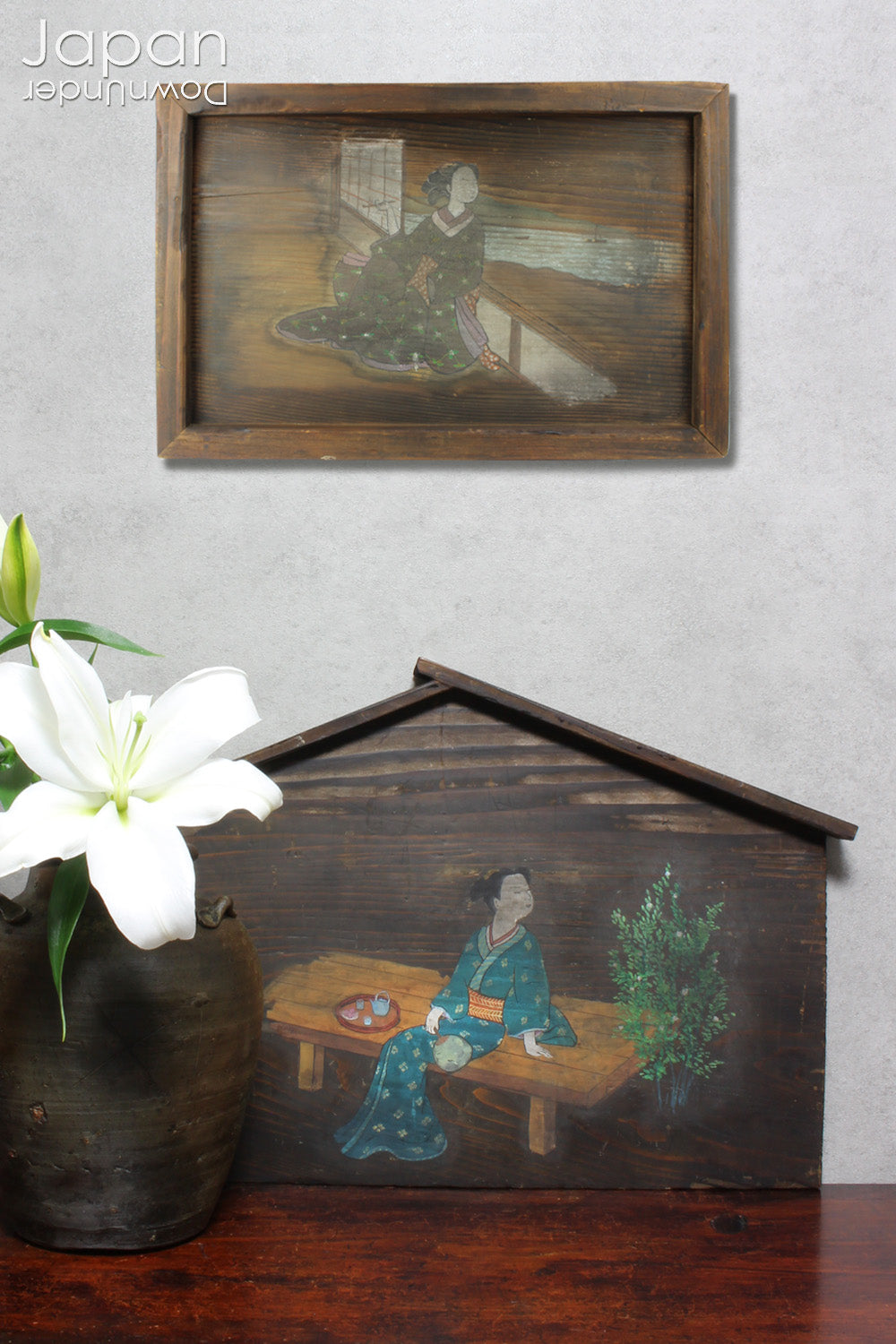My Store
large japanese antique votive plaque - beautiful woman in japanese kimono painting - religious wall art
large japanese antique votive plaque - beautiful woman in japanese kimono painting - religious wall art
Couldn't load pickup availability
Love Japanese Style Like We Do
Discover a remarkable piece of Japanese cultural history with this stunning 19th-century folk art painting - an impressive large ema adorned with the delicate image of a woman in traditional kimono. Originally created as a donation to a shrine, this rare and beautifully preserved votive plaque effortlessly blends spiritual significance with artistic elegance, making it a captivating addition to any collection or interior space.
Large ema of this scale emerged during the Edo and Meiji eras, serving a dual role beyond the smaller, purely spiritual plaques. These grand votive paintings functioned as art objects meant not only to honor the gods but also to be admired by the public. They were hung in special ema halls, that essentially acted as early gallery spaces showcasing exquisite craftsmanship.
This particular ema features a classic Bijinga painting - a genre celebrating the refined beauty, customs, and grace of women - which flourished during this era. The elegant figure, draped in a flowing kimono and holding a fan, is depicted seated on a bench, peacefully enjoying a serene garden while sipping tea. Rendered in mineral pigments directly onto wood, the ema retains its original horse-stable shape, adding unique authenticity and charm.
Inscribed delicately on the back are several meaningful details: the date “Meiji Juni Nen” (the twelfth year of Meiji, 1879), the word “Honnou” (signifying dedication or offering to the gods), and the name of the individual who commissioned this heartfelt tribute - offering a personal glimpse into its history.
Though the panel shows some expected signs of age - such as minor paint fading, gentle dents, and a slight warp beneath the roofline- it remains structurally sound and visually enchanting, making it perfect for adorning a wall art display.
This beautiful vintage ema stands as a rare and evocative example of Japanese folk art - a timeless treasure for collectors and enthusiasts who appreciate cultural heritage and artistry.
- measures around 57 cm (22.4”) across x 39 cm (15.3”) tall x 4 cm (1.6”) deep.
- weighs 630 gm.
(listing for ema only)
SHIPPING INFORMATION
- please read the shipping notes in our shop announcement.
- we use recycle packaging wherever possible and wrap for safety, rather than appearance!
ABOUT OUR VINTAGE ANTIQUE AND OTHER ITEMS
We list pieces we feel are worthy of display. There may be scratches, dents, fading and signs of wear and tear. We try to explain the condition of each item exactly, but may miss something.
Information regarding the item and it’s age is obtained from dealers and our personal research. We do our best to give you the correct information but please be aware that we cannot guarantee this information.
Please message us prior to purchase with any questions you may have about our products.
EMA
These votive plaques date to the reign of the Emperor Suinin. It was this ancient leader that instituted the use of haniwa clay figures in lieu of live burials when tombs were built for the wealthy. The horses (shimme) that were previously placed in the grave then came to be gifts to shrines. They were thought to be horses for the gods to ride. It wasn't long before these ‘gift horses’ became more trouble than they were worth. The next logical step was making a replica of these horses and so the wooden ema votive plaque came into being. Ema, literally means picture horse.
The majority of ema were wood plaques, simply fashioned in the shape of a two dimensional gabled roof stable with a prancing steed or two inside. Gradually they came to be painted with animals of the zodiac, good luck images, deities, such as Kannon and Jizo and other specific icons depending on their intended purpose.
Prayers and wishes are written on the back of the ema and they are left hanging at the shrine, where the gods are believed to receive them. They are then ritually burned at special events, freeing the wish from the writer.
LARGE EMA
During the Edo and Meiji eras another type of very large ema evolved. Although these ema had the spiritual function of the small ema, they were also objects of display and advertisement. They were a kind of spiritual and social exchange that donors performed for both the gods and the viewing public.
Large ema, were generally commissioned by donors from professional artists, but small ema were painted by individual donors or by craftspeople who mass-produced ema for sale to shrine and temple visitors. Large scale ema, like their smaller version, were painted directly onto a wooden board. The larger ema were sometimes surrounded by a frame, or took the shape of the triangular horse stable-shaped roof of the small ema. Small ema were periodically burned but large ema were not removed from their display spaces.
The combination of increased size and more frequent donations of large ema spurred temples and shrines to create additional spaces for display called ema halls, or emado. These halls became an art gallery-like space within the religious complex where ema were on view to all visitors and ema became a publicly accessible art form. Notable ema and ema halls were even mentioned in travel books and other texts from the Edo era. Religious institutions did not actively curate their collection of ema and displays grew through unorganized additions initiated by the donor, leaving a permanent advertisement for the artist and the donor.
Large ema catch many of the defining characteristics of art in the Edo and Meiji period. They are religious objects as well as art objects. They provided donors, artists, and religious institutions with an opportunity to advertise devotion to God, miracles, and their own skills.
Share
















